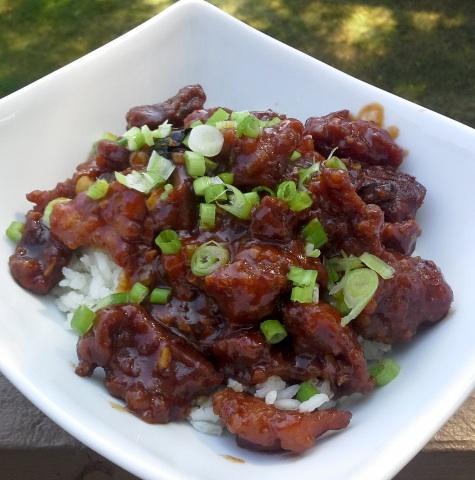A couple of years ago I was told about a book called The Scavenger's Guide to Haute Cuisine, by Steven Rinella. In the book, Rinella tells the tale of being given an old cookbook written by Auguste Escoffier and being inspired to have a feast of all the things he hunts and gathers. Rinella talks about how, pre-Escoffier, he once ate snapping turtle and didn't enjoy the turtle meat because it tasted like a mucky swamp. But then he reads Escoffier's book and in it, Escoffier says that turtles should be taken alive and kept alive for at least a week prior to butchering; the turtle needs to be kept in clean water, changing the water daily so the turtle has an opportunity to cleanse its system. In theory, this extended process will affect the way the meat tastes. These instructions convinced Rinella to try turtle again, and he enjoyed it the second time around. After reading Rinella’s book, I have been intrigued by turtles and have wanted to try catching and cooking one myself. My only problem was: Where I was going to get my hands on a live snapping turtle?
Here in Minnesota, snapping turtles are actually pretty common; I have had them in my yard and have seen them around the nearby lake. The only problem is that I only see them in the early spring until the beginning of June, but then after that they have a tendency of disappearing. Why is that a problem, you might ask? Well, here in Minnesota, it is illegal to take turtles in the months of May and June. Starting July 1st, it is legal for licensed anglers to take turtles, but if you want to use traps or trot lines you need to buy a special license. That leaves only one other way to catch turtles: to get into the water and find them. Still, I have yet to see a snapping turtle after July 1st; it’s almost as if they know I am looking for them.
On several occasions, I’ve tried to find the turtles by walking in the water and feeling along the banks of small ponds and lakes. I had read that the best way to find them is to get in the water and check the banks, as they bury themselves in the sand and mud. I am not sure what I would have done had that actually worked. Digging a turtle out of the mud could be somewhat dangerous, especially if you didn’t know where the head was. Snapping turtles are ill tempered and have tremendous bite strength, and large snappers could cause permanent damage if they were to get a hold of a finger. But all my efforts were unsuccessful anyway, and I needed to find another way of getting live snapping turtles.
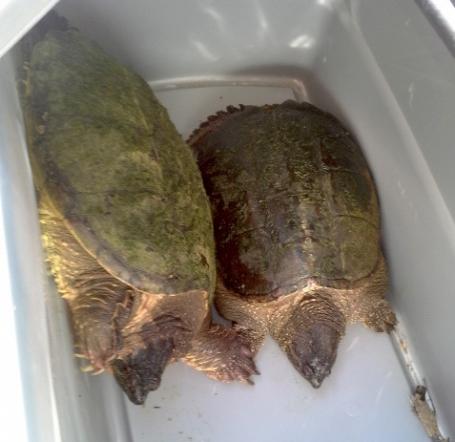 Snapping turtles, Myrtle and Meany
Snapping turtles, Myrtle and Meany
Fortunately for me, I know a guy. Several weeks ago, I was out fishing on the Mississippi River near Wabasha with my friend Eric, and we ran into Tim Adams; Tim is a friend of Eric's and runs Schafer Fisheries northern collection site in Pepin, WI, and he is also one of the stars of the Outdoor Channel’s new show Bottom Feeders. I asked Tim if he had gotten any turtles in lately, and he said he had several, so I went over Schafer’s and picked up a couple of turtles.
Once I had the turtles home, I kept them in separate tubs out in the garage and changed their water daily. The first couple of days were absolutely disgusting; I could not believe the crap that came out of those turtles. The bigger of the two had a 3-inch chunk of tree branch come out of it, and the little one had all sorts of feathers come out. After about three days, the water started getting clearer, but there was still a lot of sand and debris that was coming out, so I decided to keep the turtles alive for 2 whole weeks, still changing the water on a daily basis. I had them in the garage for so long, my daughter ended up naming them Myrtle and Meany. Meany got his name because every time I changed his water he would hiss and snap at me. When I finally decided to butcher the turtles, the water was almost as clean as when I had put it in.
When it came time to butcher the turtles, I was a little weary about the process. I live in the city so I wasn’t going to be able to shoot the turtles to kill them. I looked on the Internet and found several methods for killing turtles; all of them involved cutting the head off. I don’t usually have a problem with the killing aspect of hunting, but most of the killing I do is from a distance. Cutting the head off a live animal is something I have only done with chickens, and they don’t usually put up a fight. What I had read was you need to get the turtles to bite on to something, then you pull there neck out and cut the head off with an axe or hatchet. Let me tell you, it’s not that easy; first off, getting them to bite onto something doesn’t work. I got them to bite onto a dish towel but every time I would pull to extend the neck, they would just let go. I ended up using a different method that involved a large hook under the jaw. And getting the turtles to extend their necks is another problem all together. They don’t just stick their necks out – both turtles fought quite a bit and the whole process was far more grisly than expected.
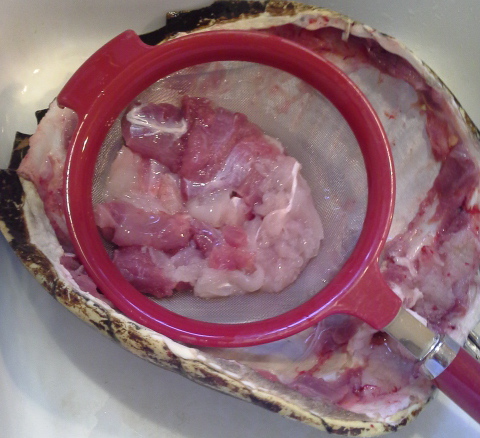 Turtle meat
Turtle meat
Once the heads were removed, I was supposed to hang the turtles for one hour so the blood could drain out of them. I did this and then went to start the butchering process, but even without their heads, both turtles were still very active and would claw and scratch at me whenever I tried to make incisions into them. I ended up leaving them for about 2 1/2 hours before they were docile enough to cut. The whole butchering process really left a bad taste in my mouth and if I ever do this again I will have to find a better technique.
When I finally got the butchering done, the whole procedure had taken me about 4 hours. What I ended up with was six pounds of turtle meat. Turtle meat is very interesting; I had read that a turtle has seven different kinds of meat in it. To my untrained eye, I could easily make out four different kinds of meat: a white fibrous meat that looked very reptilian similar to alligator or snake, a more dense white meat that looked similar to poultry, a red meat that looked similar to pheasant legs, and a darker red meat that resembled duck
The first thing I do with any meat that I have never cooked before is fry it. I find that frying is a very easy way to cook things and gives me a base line to build off of. Also frying is a nice way to ease into new meats, it is familiar technique and gives me an idea of what I can do with the meat. I soaked some of the meat in buttermilk, then dredged it in flour and fried it. I had read that turtle can be very tough and requires extra cooking, so after I fried it, I put it in a 300 degree oven for 30 minutes. What I ended up with were turtle nuggets; I made some barbecue sauce and had barbecued turtle. The meat was sweet and kind of tender – it wasn’t tough but it had some chew to it. I tried to separate out the different types of meat and try them separately to see if there was any difference in flavor, but the only real difference was between the light and dark meat. I preferred the dark meat, as it seemed to have a richer flavor; the white meat had a very neutral flavor and didn’t really taste like anything. In that way, I suppose it reminded me of chicken.
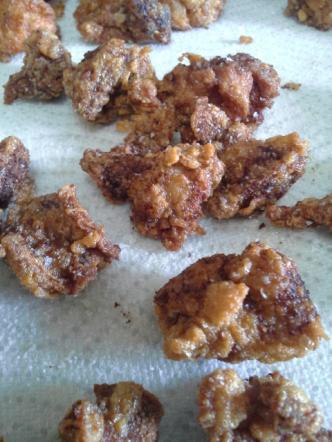 Fried turtle
Fried turtle
When I started looking for recipes for turtle, most of what I found was turtle stew, fried turtle, and of course turtle soup. I have only ever eaten turtle in soup and once in a buffet in Hattiesburg, MS where it was fried to the consistency of tree bark. I have heard many people compare turtle meat to chicken, so when I thought about what to do with it, only one thing popped into my mind: General Tso’s Turtle. I have been making General Tso’s about once a month ever since trying Hank Shaw’s recipe for General Tso’s Pheasant. It is hands down the best version I have ever had, and after the first time you make it, it isn’t all that hard. I didn’t really change anything in the recipe except that after frying the turtle I did bake it in the oven at 300 degrees for 30 minutes.
This was some of the best General Tso’s I have ever had; the turtle was not at all tough or chewy. It did have a definite unique texture, but was not tough. The chunks of white meat were very neutral in flavor and all I really got was the General Tso’s flavor. The dark meat chunks had more flavor and I could easily identify that I wasn’t eating chicken. The dark meat tasted a lot like alligator and had a similar texture: sweet and nutty with that very distinctive reptilian flavor that you know once you have had it before. I believe that letting the turtles purge themselves beforehand really helped, because there wasn’t a bit of swampy flavor in the meat.
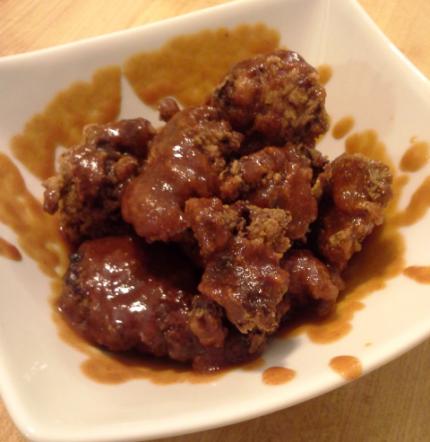 General Tso's Turtle
General Tso's Turtle
General Tso’s Turtle
Adapted from Hank Shaw
Serves 4
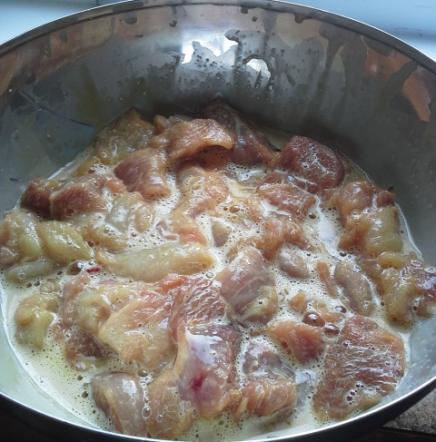 Turtle meat soakingIngredients:
Turtle meat soakingIngredients:
Marinade:
- 4 tablespoons corn starch
- 2 egg yolks
- 1 tablespoon soy sauce
Sauce:
- 1/2 cup chicken stock
- 1 tablespoon soy sauce
- 1 tablespoon brown sugar
- 1 tablespoon Chinese black vinegar
- 2 tablespoons tomato paste mixed with 2 tablespoons water
- 1 teaspoon corn starch
Stir-fry:
- 1 pound turtle meat, cut into bite-sized pieces
- 3 tablespoons canola
- 8 dried hot tien tsien chiles, broken in half and seeds shaken out (use less if you don’t want it spicy)
- 1 tablespoon grated ginger
- 3 garlic cloves, sliced thin
- 6 green onions, chopped
Instructions:
- Mix the marinade ingredients together and then add the turtle meat. Let sit for about an hour.
- Heat canola oil or your favorite frying oil to about 350 degrees and fry the turtle in small batches, being careful to not let the pieces stick together. After all the pieces are fried, place them on a baking sheet and bake in the oven for 30 minutes at 300 degrees.
- While the turtle is baking in the oven, mix together the sauce and set aside.
- In a large pan or wok, heat 3 tablespoons of canola oil and stir fry the chilies for about a minute, then add the ginger and cook for another minute, lastly add the garlic and stir it a couple of times in the pan.
- Add all the turtle pieces and the green onions to the oil. Pour the sauce mixture over the turtle and stir until it thickens. Once the sauce thickens, serve the turtle over rice with chopped fresh green onions on top.
 Jamie Carlson lives in Burnsville, MN with his wife, Amanda, and their two kids Eleanor and Charlie. He works as an Rn at the Minneapolis VA hospital. He enjoys hunting, fishing, foraging, and, of course, cooking. He believes that all food can be tasty if it is prepared with care, and he writes about his adventures cooking everything from Pickled Venison Heart to Roasted Dove on his food blog, You Have to Cook it Right. Follow him at @youcookitright. He writes the Hunting for Dinner series for SGT; his last post was Hunting for Dinner: The Perfect Fish Fry.
Jamie Carlson lives in Burnsville, MN with his wife, Amanda, and their two kids Eleanor and Charlie. He works as an Rn at the Minneapolis VA hospital. He enjoys hunting, fishing, foraging, and, of course, cooking. He believes that all food can be tasty if it is prepared with care, and he writes about his adventures cooking everything from Pickled Venison Heart to Roasted Dove on his food blog, You Have to Cook it Right. Follow him at @youcookitright. He writes the Hunting for Dinner series for SGT; his last post was Hunting for Dinner: The Perfect Fish Fry.

